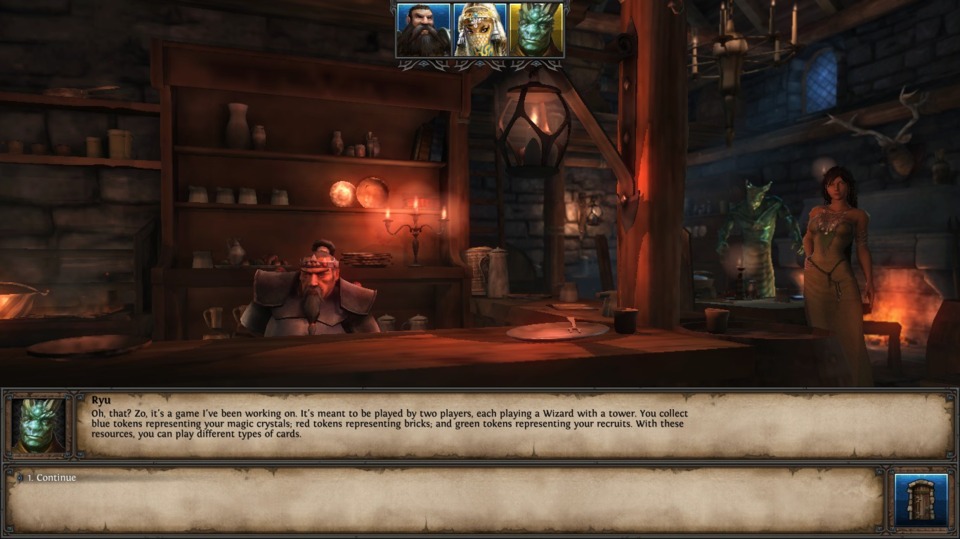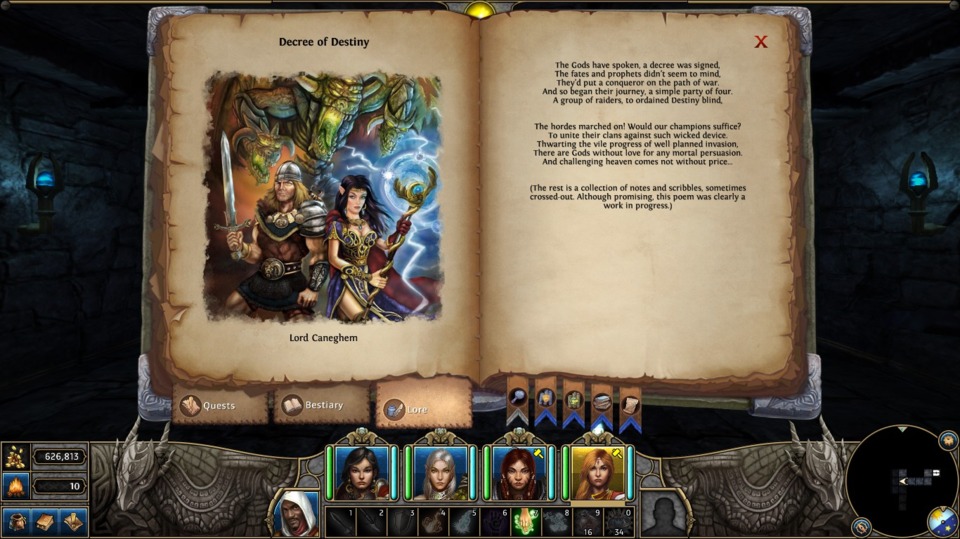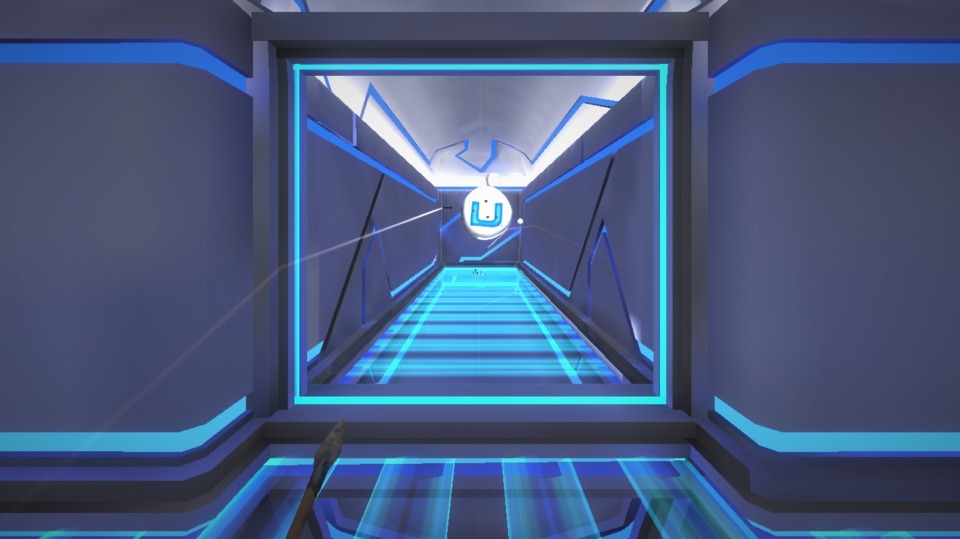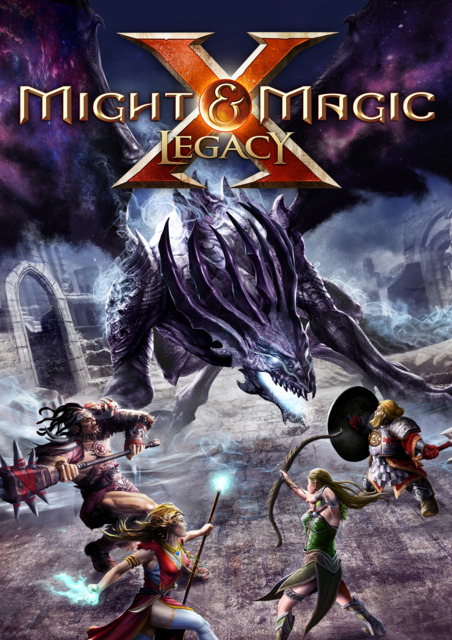One of the oldest CRPG franchises avails itself of the current throwback craze.
The one thing that can be said without a shadow of a doubt about Might and Magic X: Legacy is that it is an old-school CRPG and proud of it. It uses a very specific vintage format of the quad-directional tile-based dungeon crawler with a four-person party, far closer to the Xeen games of its venerable CRPG series (which would be Clouds of Xeen and Darkside of Xeen, or M&M IV and M&M V) than the panoramic movement real-time sequels (The Mandate of Heaven (M&M VI) to Might and Magic IX). The decision to go further back into the annals of the series for a foundation on which to build this iteration was presumably inspired by the surprise success of similar retro CRPGs like Almost Human's Legend of Grimrock and Atlus's Etrian Odyssey. However, the game is especially reverent of its Might and Magic ancestors, throwing in a lot of sly references to prior games such as reusing their distinctive sound effects (the dramatic sound whenever you entered the turn-based mode of M&M VI, VII or VIII is used here as the level-up noise, for instance), a set of poems that recount the events of the previous nine games and a tavern NPC working on "a card game with wizard towers". The mythology and world of M&MX is that of the more recent Heroes of Might and Magic games (2006's HoMM V onwards): Ashan is a land governed by six elemental dragon gods and is still reeling from the sudden renewal of hostilities between angels and demons after an apocalyptic eclipse. M&MX specifically is set on a small part of this world, the Agyn Peninsula, which is nonetheless filled with the usual assortment of ancient ruins, caves, sewers, temples and the like to explore. Visual design from dungeon to dungeon is varied enough to keep the game fresh, taking Grimrock's approach of building lush 3D terrains and dungeon dressing and imposing the gameplay's grid-like structure on top of it, and there's plenty of secrets to discover either in the dungeons themselves or scattered across the immense overworld. For what feels like a smaller Indie-scale throwback in a couple of ways, the game's setting is quite vast and will easily take most players 30-40 hours to complete the game, if not longer should they find themselves frequently backtracking for important NPCs and dungeons they originally skipped over due to their difficulty.

Might and Magic X could be considered a classic CRPG purely for how it dumps you on an island (or peninsula in this case), gives you a few vague directions for the central story questline ("go to this place and talk to the governor") and lets you loose on the world it has created. High level areas impolitely make themselves known by mercilessly killing the party instanter, so saving regularly when travelling or faced with an ominous dungeon entrance is recommended. However, if the player feels they can chance it or are confident in their abilities, they might want to try these dangerous areas sooner than the game intends: the starting region especially has a lot of caves with mano-a-mano encounters with challenging monsters and a priceless relic item as a reward. With the right tactics and skills, these monsters can be slain with guile and tactical superiority rather than brute force, providing the party with a powerful item early on. Relics in particular are weapons, equipment and accessories that start as ordinary magic items but gain XP along with the player characters, eventually becoming extremely powerful after enough of the game has progressed. It's a neat idea, as it means getting the item early won't necessarily mean that you'll be bringing down important bosses with little effort any time soon, but it will ensure that you're working towards a potent asset for the mid- to late-game.
True to its old-school roots, the game can be overly harsh about a number of its combat features, especially where status effect conditions are concerned. Weakness (greatly reduces strength and accuracy), poison (saps health every turn) and feebleminded (prevents the use of magic) can be cured by resting or with cheap potions, but are otherwise permanent until treated. A poisoned character will fall unconscious quickly when moving around outside of combat, and a feebleminded mage or weak fighter is effectively useless until fixed. Conditions like paralysis are permanent until treated as well, and require high level spells to shift, though it also goes away if the character gets knocked unconscious. Sometimes these conditions necessitate a speedy exit to the nearest church to restore. The game has a moderate emphasis on elemental weaknesses as wells, and having a diverse magic user in the group can ensure that you aren't coming up against monsters that are all but immune to your specific elemental focus. It has conveniences as well, of course, such as maps the player can annotate or the game's auto-save feature which records the player's progress whenever they enter a new area or rest for a spell. Party members only ever die (which is to say, actually expire, rather than fall unconscious) if they lose their entire health bar twice over, which gives the player some amount of leeway. Don't expect monsters to pass over unconscious party members, however.

Might and Magic X doesn't retain much of the "modern" (VI-IX) Might and Magic experience, save for the series' distinctive skill progression system. In order to increase a character's aptitude for certain skills, the player must spend skill points they earn with every level up on various disciplines: the assortment of disciplines are different for each of the classes, as is the level of mastery they can reach. For instance, a Paladin can learn "Grandmaster"-level Light Magic, Sword and Heavy Armor skills, whereas most other classes cannot. However, in order to acquire each skill level ("Expert", "Master" and "Grandmaster") the player must find the right trainer and pay them for their time. Locating these trainers becomes a meta-quest of its own. Unfortunately, unlike VI-IX, the game never deigns to record where these trainers are or the hints you're given to their locations, so it's left to the player to keep track via the in-game maps or a handy notepad (or use an online guide, if you're really not in the mindset). The game does, however, record the statistics of monsters you've faced, with more details emerging as more monsters of that type are slain. There's also other minor additions and callbacks from the previous Might and Magics, such as barrels filled with colored liquids that increase various stats.
X reflects the philosophy of the Might and Magic games regarding monster saturation, insofar as those games were fond of creating scenarios where the party would have to fight many, many enemies at once and be more mindful of their crowd control spells and abilities. Only two medium-sized (or three small) enemies can occupy a single tile, so instead the game presents scenarios where the player walks onto a crossroads tile and is suddenly ambushed on all sides by enemies. While annoyingly prevalent, and somewhat inexplicable as enemies pour in from areas you've ostensibly already cleared, it does make battles all the more challenging and tactical. It becomes a game of determining which flank to deal with first, taking advantage of ranged abilities and carefully studying the passive abilities of the enemies you face. For instance, an enemy might have the "Vindictive" trait, which increases their number of attacks for every blow that they dodge or evade; subsequently, characters with multiple hits (such as a dual-wielding dagger Ranger) or powerful special attacks that have a higher than usual probability of missing the target are best benched in favor of sure, safe hits. There are many of these enemy traits, and it behooves the player to learn them fast or else they'll find themselves getting mowed down by common monsters before they realize their mistake.

On the whole, there's a dilemma here regarding whether to rate the game as a modern day CRPG against contemporaries like Dragon Age: Inquisition or Divinity: Original Sin, or as the deliberate throwback CRPG it wishes to be. As a modern CRPG, it falls a little short, and I can't help but feel disappointed that the developers threw away not only the years of enhancements and progress made to the genre since the Xeen games way back in the early 90s, but to the Might and Magic series itself in the intervening 20+ years. While the Might and Magic VI engine was already feeling its age by VIII, there was a certain additional degree of freedom and strategy to that format, especially when you had a dozen monsters slowly edging towards you from multiple directions and had to determine how best to fight them off before too many got within melee range. Might and Magic X does what it can in that regard with its overwhelming ambushes, but its combat feels far too languid and methodical in comparison, which can greatly drag down the pace of the game. However, were I to judge this game based solely on its intent to revisit a historical period of first-person dungeon crawlers with a satisfactory amount of modern conveniences, I can't say that it doesn't manage it with aplomb.
Many Indie titles are happy to wallow in the past; to return to ancient, outdated genres to plunder what they can from those hoary features and antique conceits to create something that frames contemporary gameplay within an archaic yet nostalgic model. If that's what you're looking for, and/or can still remember CRPGs from that far back, I believe Might and Magic X will satisfy.
